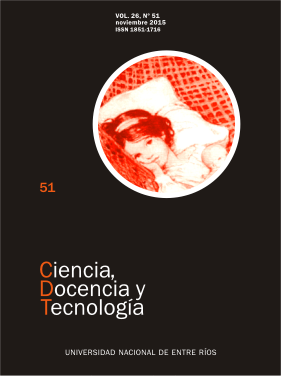Abstract
This article presents the results of a research carried out on a proposal for teaching and learning assessment of a course of Geography for the professional training of designers of the landscape and urban planning based on the use of the case method. It also discusses the relationship between the didactic strategy adopted and modalities of studies of students. We take into account perspectives, teaching and student. The design and development of the class takes a geographical approach that take advantage of social conflicts in specific spaces and conceives a profession that takes into account the different perspectives of those who make use of the space. We emphasize coherence between teaching and learning assessment; the case method has a central role and takes real cases as a resource, generating motivation and approach to the profession. In the context, we recognize that the modality of study focused on applying concepts to possible situations of professional practice.
References
-AUGE, M. (1996). Los no lugares. Espacios del anonimato. Una antropología sobre la modernidad. Madrid: Gedisa.
-BARBIER, J. M. (1999). Prácticas de formación, evaluación y análisis. Buenos Aires: Noveduc.
-BIGGS, J. (1996). Assessing learning quality: reconciling institutional, staff and educational demands, en: Assessment & Evaluation in Higher Education, 21 (1): 5-15.
-CAMILLONI, A. (1998). La calidad de los programas de evaluación y de los instrumentos que los integran. (67-92). En CAMILLONI, C. y ots. (Comp.) La evaluación de los aprendizajes en el debate didáctico contemporáneo. Buenos Aires: Paidós.
-CAMILLONI, A. (2002). Los obstáculos epistemológicos en la enseñanza. Madrid: Gedisa.
-CAMILLONI, A. (en prensa). Para construir un caso. El estudio de casos como estrategia de enseñanza. (mimeo).
-CAMILLONI, A. y COLS, E. (2010). La problemática de la investigación didáctica: El caso de una investigación sobre formatos de evaluación de los aprendizajes y sus relaciones con las modalidades de estudio de los alumnos universitarios. (pp. 127-143). En WAINERMAN, C. y DI VIRGINIA, M. (Comps.) El quehacer de la investigación en educación. Buenos Aires: Manantial.
-DENZIN, N.K. & LINCOLN, Y.S. (2011). El campo de la investigación cualitativa. Barcelona: Gedisa.
-DOYLE, W. (1986). Trabajo Académico. Traducción de la cátedra de Didáctica II, Facultad de Filosofía y Letras, Universidad de Buenos Aires del artículo aparecido en T. M. Tomilson & H. J. Walberg, Academic work and educational excellence: Raising student productivity. Berkeley, McCutchan.
-ENTWISTLE, N. (2000). Promoting deep learning through taching and assessment: conceptual framework and educational contexts. Paper presented at the TLRP Conference, Leicester, England, November 2000.
-FERNANDEZ CASO, M. V. y GUREVICH, R. (2007). Geografía. Nuevos temas, nuevas preguntas. Un temario para su enseñanza. Buenos Aires: Biblos.
-GUREVICH, R. (1994). Un desafío para la Geografía: explicar el mundo real. (pp 63-84). En AISENBERG, B. y ALDEROQUI, S. (Comps) Didáctica de las Ciencias Sociales. Aportes y reflexiones. Buenos Aires: Paidós.
-HAMILTON, D. (1980). Contraste de supuestos entre el análisis de muestras y el estudio de casos en la investigación. (pp. 95-143). En Gimeno Sacristán, J. y Pérez Gómez, A.I. (Comps.) La enseñanza, su teoría y su práctica. Madrid: Akal.
-LAVE, J. (1996). La práctica del aprendizaje. (pp.14-45). En CHAIKLIN, S. y LAVE, J. (Comps). Estudiar las prácticas. Perspectivas sobre actividad y contexto. Buenos Aires: Amorrortu.
-LITWIN, E. (2008). El oficio en acción: construir actividades, seleccionar casos, plantear problemas. (pp. 89-116). En LITWIN, E. El oficio de enseñar. Condiciones y contextos. Buenos Aires: Paidós.
-MARTON, F. & SALJÖ, R. (1976). On qualitative differences in learning I. Outcome and process, en: British Journal of Educational Psychology, 46: 4-11.
-PERRENOUD, P. (1990). La construcción del éxito y del fracaso escolar. Madrid: Morata.
-PERRET CLERMONT, A. y NICOLET, M. (1998). Interactuar y conocer. Desafíos y regulaciones sociales en el desarrollo cognitivo. Buenos Aires: Miño y Dávila.
-SALOMON, G. (1993). No hay distribución sin la cognición de los individuos: un enfoque interactivo dinámico. (pp.153-184). En SOLOMON, G. (Comp.) Cogniciones distribuidas. Consideraciones psicológicas y educativas. Buenos Aires: Amorrortu.
-SAUTU, R. (2003). Todo es teoría. Objetivos y métodos de investigación. Buenos Aires: Lumiere.
-SHEPARD, L. (2000). The role of classroom assessment in teaching and learning. Colorado: Cresst.
-SOUTO, M. (2010). El carácter de “artificio” del dispositivo pedagógico en la formación para el trabajo. Buenos Aires: OPFyL.
-WASSERMAN, S. (2006). El estudio de casos como método de enseñanza. Buenos Aires: Amorrortu.
-WIGGINS, G. (1990). The case for authentic assessment. Practical Assessment, Research & Evaluation, 2(2): 1-6.
The authors retain the copyright and grant the journal the right to be the first publication of the work, as well as licensing it under a Creative Commons Attribution License that allows others to share the work with an acknowledgment of the authorship of the work and publication initial in this magazine. All content is published under the Creative Commons 4.0 international license: Attribution-Non-Commercial-Share Alike.

